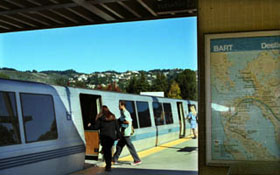

![]()
|
|
|
|
The Measure B sales tax in Alameda County would be used for transportation improvements, including expansion of the BART system. |
|
|
Alameda County Measure B and Santa Clara County Measure A each passed the two-thirds mark needed for approval. Both measures will extend existing half-cent sales taxes that supplement state and federal funding of local transportation needs. Measure A passed with a comfortable 70.4% of the vote, while Alameda County's Measure B was resoundingly approved with more than 80% of the vote. Each faced the high hurdle set by Proposition 218 in 1996 that requires a two-thirds majority to approve local tax levies for transportation. This "supermajority" requirement frustrates many in the transportation and planning community. "While it's great that we need two-thirds to amend the U.S. Constitution, supermajority funding doesn't make sense for local government," said Tess Kouyate, public relations specialist for Alameda County Transit Authority. The result of a contentious and heavily-funded race, Santa Clara County's Measure A provides $6 billion of funding for transportation initiatives in Silicon Valley, focusing on projects to benefit San Jose over a 30-year period starting in 2006. The pro-Measure A forces, led by the Silicon Valley Manufacturing Group (SVMP), an industry group that includes dot-com powerhouse companies such as Hewlett-Packard, Adobe and Sun Microsystems, poured approximately $2 million to the campaign. By contrast, the anti-Measure A forces had about $50,000 to spend and contended that the process that produced the measure was flawed - that it was too short, lacked public input and was pushed through by well-funded industry leaders. "Now our real work begins," said Kimberly Strickland, Silicon Valley Coordinator of the Bay Area Transportation and Land Use Coalition, an organization opposing the measure. "We have to ensure that the projects and programs promised in Measure A are really delivered." Strickland expressed concern that the high price of BART and cost overruns that have plagued previous BART projects may siphon funds away from busing and road repair. Measure A supporters argued that the traffic problems in the Valley required immediate action, no matter how flawed the initiative. Local newspapers, including the San Jose Mercury News, supported the measure. In its editorial supporting the measure, the Mercury News outlined what the editors regarded as flaws of Measure A, and gave it only conditional support. Apparently this was enough to convince Valley voters. "It goes to show what happens when you have the ability to flood voters with commercials that may or may not be true," said Strickland. Mercury News publisher Jay T. Harris is on the SVMP board of directors. Measure A was opposed by most of the Santa Clara County Board of Supervisors, including Supervisors Blanca Alvarado, who is also chair of the Valley Transportation Authority and James Beall, who is chair of the Metropolitan Transportation Commission. The BART Board declined to take a position on the measure. BATLUC has criticized Measure A's focus on extending BART from Fremont to downtown San Jose and the resulting emphasis of a single transit corridor in the East Bay. "This deals with congestion in only one gateway corridor, the East side, when we see a lot of people moving to the southern part of the county in the future," Strickland said. Alameda County's Measure B extends a half cent transportation sales tax for 15 years beyond its previously scheduled termination of 2002 and would raise some $7 billion in transit funding to provide transit dollars to BART, AC Transit buses, road repair, creation of bicycle lanes and transportation for the disabled. Last year, the tax provided $10-11 million for AC Transit buses and provided funding for filling more than half the potholes repaired in Alameda County. In contrast to Santa Clara's Measure A, Measure B was one of the most well-supported local ballot initiatives in recent memory. The follow-up to a failed 1998 ballot initiative, Measure B was the result of a three-year process that brought together community groups, environmentalists, county officials, and transportation planners for numerous meetings. In the end, participants gave the measure unanimous support, and the Measure B process is being heralded by groups such as the Sierra Club, the Amalgamated Transit Union, Local 192, and the League of Women Voters as the model for crafting local transportation initiatives. "We think we did a good job on the process," said Christine Monson, Executive Director of Alameda County Transit Authority. "This is stuff that's not so exciting, but it's essential to our community."
|
||


